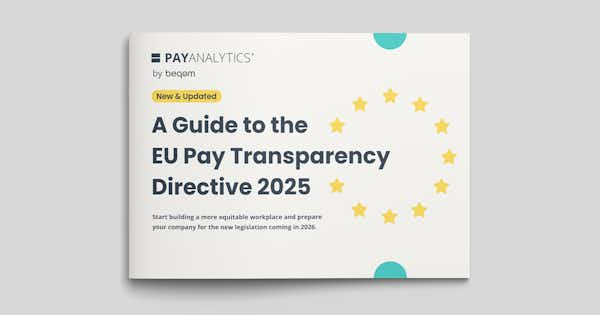A Guide to the EU Pay Transparency Directive 2025 | Download our eGuide for free

Finland – EU Directive draft legislation and current pay gap reporting requirements
On May 16, 2025, Finland’s government working group published draft legislation that would constitute a full transposition of the EU Pay Transparency Directive by amending Finland’s existing Equality Act.
Nations across Europe are working to transpose the EU Pay Transparency Directive into local law ahead of the June 2026 deadline. In Finland, the Ministry of Social Affairs and Health set up a working group on Directive transposition, and this group published its draft legislation on May 16, 2025. This legislation would constitute a full transposition of the EU Directive by amending Finland’s Act on Equality between Women and Men (609/1986) (Equality Act).
This article outlines current pay equity reporting requirements in Finland, then looks at the draft legislation to transpose the EU Directive.
In this page we keep track of transposition activity at the jurisdiction level. We update it regularly as the EU member states continue on their journeys towards full legal implementation of the Directive.
Current pay equity legislation and reporting in Finland
Finland’s current pay equity legislation is located in the nation’s Equality Act and affects employers (public and private) with 30 or more employees.
Every two years, these employers need to submit a gender equality plan. This plan is fairly comprehensive, and if the business has any elected employee representatives, they must be involved in preparing the plan. The plan must include:
1️⃣ A gender equality assessment, which includes a breakdown of employees by job and gender and a pay survey. Employers should present:
- Demographics: job classifications and number of men/women in each job class.
- Overall pay and difference by gender for each job classification. If there is an objective explanation (that does not involve gender bias) for any pay differences, the gender equality plan should include it.
2️⃣ Any corrective actions planned to remediate any pay gaps, and any other measures planned to advance pay equality and gender equality in the organization.
3️⃣ Retrospective on any measures specified in previous gender equality plans: have those measures been implemented, and what were the results?
Unlike in some other nations, these reports are not submitted directly to the Finnish government but rather shared with employees and representatives of workers’ organizations. However, the government can ask to see the plan.
Finland does not currently have specific pay transparency legislation, but the Equality Act does influence recruitment and promotion, specifically:
- Job postings/promotion should be designed to attract all genders.
- Recruiting should be equitable across genders.
- Everyone should have equal opportunities for advancement.
Finland’s draft legislation: Proposed amendments to the Equality Act
The Finnish government previously stated that it intended to stay close to the Directive’s minimum requirements and not make its legislation more stringent.
We discuss the Directive’s requirements in more detail in our EU Directive Pocket Guide and in depth in our Preparing for the EU Pay Transparency e-book.
By and large, the Finnish draft legislation does seem to parallel the Directive’s requirements. However, there are a few nuances worth noting:
Reporting on salary development criteria.
A proposed amendment to Section 6 of the Equality Act would add subsection 3, which would require employers with 50 or more employees to provide employees with information about the criteria that it uses for salary development. (This criteria must be in an easily accessible form.)
Pay range notification.
The draft legislation mentions that employers may choose to include pay ranges in job postings. But it does not require it. It requires only that the pay range be given to job candidates before salary negotiations.
Salary comparisons.
As the Directive specifies, employees can request a salary comparison between their pay and the pay of comparable employees. Finland’s draft legislation gives employers a relatively generous timeline for this, requiring them to respond (in writing) within two months.
Fines for non-compliance.
Lastly, the draft legislation authorizes fines for noncompliance with the joint pay assessment. These fines have a broad range of 5,000-80,000 Euro and would be levied for failure to submit an assessment or submitting one that is clearly deficient. The legislation also extends the time limit for making pay discrimination claims from two years to three (from the date when an employee becomes aware of discrimination against them).
Effective date.
The draft legislation is scheduled to take effect on May 18, 2026. However, it is open to revision and it is very possible that it may undergo changes before implementation. This is particularly true as some groups have voiced concern over the draft.
Pay equity data reporting
The proposed reporting process for pay equity data is interesting and merits special discussion. Employers would submit data directly to Finland’s Incomes Register, and the government’s statistics office (Statistics Finland) will analyze and compile the data. This includes calculations for:
- The gender pay gap (median and mean)
- The gender pay gap (median and mean) in terms of additional compensation or variable items (like bonuses and benefits)
- Proportion of male/female employees receiving additional compensation or variable items (like bonuses and benefits)
- The proportion of female and male employees in each quartile wage class.
However, the draft legislation also requires employers to complete one set of calculations on their own: a breakdown of gender pay gaps by job category. Employers would need to report this breakdown to the government, and they would also be required to communicate it to employees and organization representatives.
Employer group opposition
Although the Finnish government contends that its draft legislation constitutes a bare-minimum approach to transposition, some employer groups argue that it’s legally flawed, especially since the Equality Act already mandates equal pay, and that it goes beyond the Directive’s requirements. They further contend that the draft legislation would undercut competition and homogenize salaries within industries, and they note concern about the administrative burden resulting from the requirement to communicate pay information with employees. Several groups, including the Federation of Finnish Enterprises, the Association of Finnish Local and Regional Authorities (KT), the Confederation of Finnish Industries (EK), and the national church’s labor organization, have jointly issued a dissenting opinion on the legislation.
We’ll keep tracking transposition activity in Finland as the current draft bill progresses and as new legislation is introduced. We are also tracking transposition activity among all EU member states on this page.
Further support with PayAnalytics by beqom
We’ll continue to track EU Directive transposition throughout the EU. But regardless of how the legislation may develop and change, PayAnalytics by beqom was designed to make things simple. If your company needs to revamp its salary structure to have clear job categories and pay ranges, our pay equity analysis function gives you the insight you need to make informed changes. It’s also the perfect tool for companies that want to shrink or close their pay gaps before the legislation takes effect.
To meet any local reporting requirements applicable to your organization, our platform provides a suite of built-in reports tailored for countries worldwide. Our system currently allows clients to generate pay data reports for Finland with the click of a button. As new Directive-compliant laws take effect, we will continue to update our built-in reports to streamline local reporting—including Finland’s proposed breakdown of gender pay gaps by job category—for our EU clients.
And in addition to our reporting and analytical features, our pay equity software helps you make data-driven decisions for new hires and promotions, so your organization can achieve and sustain pay equity.
To see what we can do for your organization, whatever its location, size, or industry, we invite you to book a demo to see how we can help you comply with and even benefit from your local regulations.





